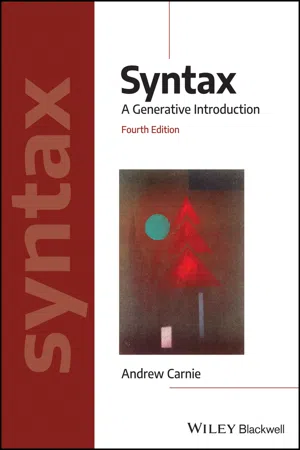
- English
- ePUB (mobile friendly)
- Available on iOS & Android
About this book
The extensively updated fourth edition of the leading introductory textbook on theoretical syntax, including an all-new chapter and additional problem sets
Now in its fourth edition, Andrew Carnie's Syntax: A Generative Introduction remains the leading introduction to the rules, principles, and processes that determine the structure of sentences in language. Comprehensive yet accessible, the text provides a well-balanced, student-friendly introduction to syntactic theory. Topics include phrase structure, the lexicon, binding theory, case theory, movement, covert movement, locality conditions, ditransitives, verbal inflection and auxiliaries, ellipsis, control theory, non-configurational languages, and more. Students are provided with numerous exercises and pedagogical features designed to strengthen comprehension, review learning objectives, test knowledge, and highlight major issues in the field.
The fourth edition features revised material throughout, including a new section on Chomsky's Merge and additional problem sets in every chapter, while new examples throughout the text broaden the appeal and relatability of the text to a more diverse set of students. The optional The Syntax Workbook: A Companion to Carnie's Syntax has also been thoroughly revised and expanded to offer students the opportunity to practice the skills and concepts introduced in the primary text. This classic textbook:
- Presents authoritative and comprehensive coverage of basic, intermediate, and advanced topics
- Includes ample exercises and clear explanations using straightforward language
- Offers extensive online student and instructor resources, including problem sets, PowerPoint slides, an updated instructor's manual, author-created videos, online-only chapters, and other supplementary material
- Features a wealth of learning tools, including learning objectives, discussion questions, and problems of varying levels of difficulty
In the new fourth edition, Syntax: A Generative Introduction remains an essential textbook for beginning syntacticians, perfect for undergraduate and graduate course in linguistics, grammar, language, and second language teaching.
Available as a set with The Syntax Workbook: A Companion to Carnie's Syntax, 2nd Edition
Frequently asked questions
- Essential is ideal for learners and professionals who enjoy exploring a wide range of subjects. Access the Essential Library with 800,000+ trusted titles and best-sellers across business, personal growth, and the humanities. Includes unlimited reading time and Standard Read Aloud voice.
- Complete: Perfect for advanced learners and researchers needing full, unrestricted access. Unlock 1.4M+ books across hundreds of subjects, including academic and specialized titles. The Complete Plan also includes advanced features like Premium Read Aloud and Research Assistant.
Please note we cannot support devices running on iOS 13 and Android 7 or earlier. Learn more about using the app.
Information
Part 1
Preliminaries
Chapter 1
Generative Grammar
Learning Objectives
- Explain why language is a psychological property of humans.
- Distinguish between prescriptive and descriptive rules.
- Explain the scientific method as it applies to syntax.
- Explain the differences between the kinds of data gathering, including corpora and linguistic judgments.
- Explain the difference between competence and performance.
- Explain the difference between i-language and e-language
- Provide at least three arguments for Universal Grammar.
- Explain the logical problem of language acquisition.
- Distinguish between learning and acquisition.
- Distinguish among observational, descriptive, and explanatory adequacy.
0. PRELIMINARIES
Table of contents
- Cover
- Table of Contents
- Series Page
- Title Page
- Copyright Page
- Dedication Page
- Editor Page
- Preface and Acknowledgments
- Part 1 : Preliminaries
- Part 2 : The Base
- Part 3 : Movement
- Part 4 : Advanced Topics
- Conclusions and Directions for Further Study
- References
- Index
- End User License Agreement